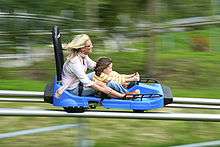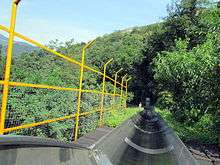Summer toboggan
A summer toboggan is an amusement or recreational ride which uses a bobsled-like sled or cart to run down a track usually built on the side of a hill. There are two main types: an Alpine coaster or mountain coaster is a type of roller coaster where the sled runs on rails and is not able to leave the track, whereas with an Alpine slide the sled simply runs on a smooth concave track usually made of metal, concrete or fiberglass. Both of these types of ride are sometimes denoted with the German name Sommerrodelbahn.
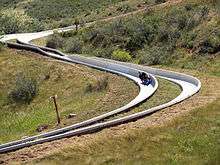
They are often built by ski resorts in order to use existing winter infrastructure and provide additional summer income, although some installations are part of amusement parks or are standalone.
As of 2007, the longest summer toboggan in the world is the 17,400 feet (5,300 m) long Tobotronc alpine coaster at Naturlandia in Andorra.[1] The highest in the world is the 3,300 feet (1,000 m) long Glacier 3000 alpine coaster in Gstaad, Switzerland which starts at an elevation of 9,747 feet (2,971 m).[2]
The type of track, safety features, speed and layout vary by manufacturer. The inventor of the Alpine coaster and a leading manufacturer of both types, with over 130 installations throughout the world, is Wiegand Sports GmbH.
History
The first form of summer toboggan was the alpine slide, which started in its present form in the 1970s. Josef Wiegand had envisioned the idea of creating a roller coaster ride for ski resorts that would take advantage of the topography of the land, rather than building a structure to create the elevation changes that traditional roller coasters required. His company Wiegand, incorporated since the late 1960s and based in Rasdorf in Germany, installed the first alpine slide with stainless steel tracks, rather than the customary fiberglass or concrete tracks, in 1975. The company developed and installed its first alpine coaster, under the "Alpine Coaster" trademark, in 1997.[3] However, a contradicting account shows that Brandauer installed its first alpine coaster in 1996 at the Karkogel Resort in Abtenau, Austria.[4][5]
Since 2006 the headquarters of Wiegand Sports GmbH has been located in Stevensville, Montana, in order to stay competitive and be able to provide service to their North American customers. Here they engineer, project manage and store spare parts and material in a 30,000 square feet (2,800 m2) facility with 20 employees as of 2016. Manufacturing is still done in Rasdorf, Germany where over 350 people are employed.
There are 36 alpine coasters in North America, of which 30 were designed and built by Wiegand. Their first alpine coaster was built in Glenwood Springs, Colorado and the next was Park City, Utah.
In 2007 a new manufacturer Alpine Products emerged, and in 2010 their business and assets were purchased by Aquatic Development Group (ADG). Since the purchase, ADG has manufactured and installed alpine coasters at 7 locations including Killington Resort, Copper Mountain and Ober Gatlinburg among others.
Construction
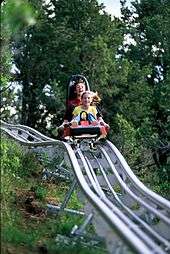
Most summer toboggans are installed by ski resorts as an added year-round attraction, or they may be installed seasonally to augment income during summer months. For the latter purpose they are built using easily removable tracks that are placed over the pistes after the ski season.[6] The tracks are devised for easy installation, with minimal impact to the topsoil and environment, as they are normally built close to the ground and take advantage of the natural elevation of the terrain. No concrete work is needed, except at the station.[7] Bridges and pillars up to 5 metres (16 ft) tall can be incorporated to negotiate roads, trails, ski slopes or water crossings.[8] The track material is usually aluminum or stainless steel for low maintenance and durability.
Closed-loop tracks include a lift system during the course of the ride. Some ski resort rides eliminate the long tedious climb up to the top by utilizing an existing ski lift to take riders to the top of the course, so that they can simply take a one-way downhill run back to the start station.[9] Alpine coasters are always closed-loop runs.
Additional thrill elements for alpine coasters can include varying degrees of curves, dips and hairpin turns.[8] Large spiral circles (helixes) can be used not only as a thrill element, but also for reducing elevation.[3]
Depending on the track and brake materials, summer toboggans can sometimes operate throughout the year, even in light rain and snow.[10]
Operation
Each sled accommodates one or two passengers and is controlled by a hand brake lever located either on both sides or in the middle. Riders are advised to keep their hands on the brake at all times for safety reasons.[11] Pulling the brake handle causes the sled to slow down or stop; pushing or letting go of the handle causes the brakes to release, allowing the sled to accelerate.[9] With this control comes responsibility: the rider must ensure that they do not go too fast as otherwise accidents can happen, although with a properly designed installation this should not be possible.
Summer toboggans are unique among amusement park rides in that the rider has complete control over his or her speed and ride experience. Riders can opt for a slower leisurely run, or one with minimal or no braking for a faster thrilling ride.[12]
Safety
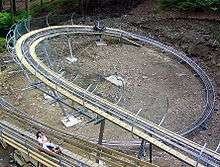
Most alpine coaster carts are equipped with a centrifugal brake system that controls its maximum speed by limiting the rotational speed of the running wheels. Some newer generation coasters are equipped with an anti-collision system that automatically apply the brakes if the rider gets too close to the one ahead. Each cart is equipped with shock-absorbing front and rear bumpers in case of collision.
Even with such safety systems available, riders on both types of runs are responsible for and are required as a common courtesy to keep a safe braking distance from any riders in front of them. To secure the riders in their seats, each car is equipped with safety belts for the rider and any passenger. Riders are also advised to wear suitable clothing without long loose parts, and to secure pockets and other items that could be lost.
Tracks may also have safety nets installed, especially on steep curves, as a last resort precaution.
Locations
External links
| Wikimedia Commons has media related to Mountain coaster. |
References
- "Tobotronc".
- "Alpine Coaster" Archived July 14, 2014, at the Wayback Machine. Glacier 3000. Retrieved on July 8, 2014.
- "All About Alpine Coasters". Coaster 101. Retrieved on July 17, 2014.
- "Alpine Coasters". AceOnline. Retrieved on July 24, 2014.
- "Referenzen (tab) > 'Österreich' ". Brandauer. Retrieved on August 17, 2014.
- "Summer Toboganning System". Brandauer. Retrieved on July 20, 2014.
- "Rolba Bob Product Features". Fun Construct. Retrieved on July 25, 2014.
- "About Alpine Slides & Alpine Coasters". Alpine Slide Directory. Retrieved on July 8, 2014.
- deathbyillusion (March 6, 2011). "Alpine Coaster Winter On-ride (Complete HD Experience) Park City Mountain Resort". YouTube. Retrieved on July 8, 2014.
- "Frequently asked Questions". Smoky Mountain Alpine Coaster. Retrieved on July 8, 2014.
- "Alpine Coaster" Archived July 2, 2014, at the Wayback Machine. Park City Mountain Resort. Retrieved on July 8, 2014.
- davidjellis (December 3, 2011). "Long Alpine Coaster (Imst) - no brakes!". YouTube. Retrieved on July 8, 2014.
